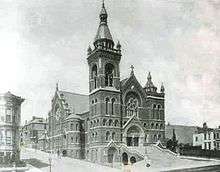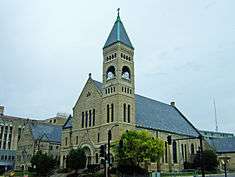James J. Egan
| James J. Egan | |
|---|---|
| Born |
1839 Cork, Ireland |
| Died |
December 2, 1914 Chicago, Illinois |
| Nationality | USA |
| Known for | Architect |
James J. Egan, FAIA, (1839, Cork, Ireland—December 2, 1914, Chicago, Illinois) was an Irish-American architect and fellow of the American Institute of Architects practicing in Chicago, Illinois. He was a partner of the Chicago architectural firms Armstrong & Egan, Egan & Kirkland and Egan & Prindeville, which gained prominence designing Roman Catholic structures.
Early life
Born in Cork, Ireland, Egan graduated from the Government School of Design, Queens College, Cork.[1] He emigrated to the United States through Castle Garden, New York City and "worked in the offices of several prominent New York architects, including Richard Upjohn and Edward Tuckerman Potter".[2]
Chicago Architect
He relocated to Chicago, Illinois, either around 1870 or shortly after Chicago's great fire in 1871, where he was heavily involved in reconstruction, and formed several partnerships with fellow architects.[2] With John M. Armstrong, the firm of Armstrong & Egan designed the Criminal Court and County Jail (1874).[2] With Alex Kirkland, the firm of Egan & Kirkland designed the County Building (1882)[2] and the four-story Hotel Saint Benedict Flats (Chicago, Illinois) (1882–1883).[3] With Charles H. Prindeville, the firm of Egan & Prindeville (active from 1897 to 1914) gained prominence building Roman Catholic churches and other structures, including the Cathedral of Cathedral of St. Paul (1906).[2] Egan died in 1914. The firm continued under Charles Prindeville after Egan's death.[2]
Works
- The Criminal Court and County Jail (1874), as Armstrong & Egan[2]
- The County Building (1882), as Egan & Kirkland[2]
- Hotel Saint Benedict Flats (Chicago, Illinois), 801 North Wabash Street (1882–1883), a four-story hotel, as Egan & Kirkland[3]
- Church of St. Thomas the Apostle (1885), Beloit, Wisconsin
- St. Mary's Church (1888, demolished in 2009), Clinton, Iowa,[4]
- St. Mary of the Assumption Cathedral in San Francisco, California (1891, destroyed by fire in 1962)[5]
- Sacred Heart Cathedral in Davenport, Iowa (1891)[4]
- St. Ambrose Cathedral in Des Moines, Iowa (1891)[4]
- St. Paul's Church in Burlington, Iowa (1895)[6]
- St. Francis de Sales Church (1899, demolished), Keokuk, Iowa[4]
- St. Vincent de Paul Church in Chicago (1897)
- St. Paul Cathedral in Pittsburgh, Pennsylvania (1906), as Egan & Prindeville[2]
- St. Pius V Church, Pilsen neighborhood, Chicago, IL
- St. Bridget Church Chicago, Il (demolished, 1992)
Gallery
Structures designed by James J. Egan
-
Church of St. Thomas the Apostle (Beloit, Wisconsin), 1885
-

St. Mary of the Assumption Cathedral (San Francisco, California), 1891
-

St Ambrose Cathedral (Des Moines, Iowa), 1891
-
Sacred Heart Cathedral (Davenport, Iowa), 1891
-

St Paul's Catholic Church (Burlington, Iowa), 1895
-

St. Vincent de Paul Church (Chicago, Illinois), 1897
-

St. Paul Cathedral (Pittsburgh, Pennsylvania), 1906
References
- ↑ James J. Egan at the archINFORM database.
- 1 2 3 4 5 6 7 8 9 Decker, Kevin F. " James J. Egan (d.1914)", University of Plattsburgh, New York (2000)
- 1 2 Chicago Architecture Info
- 1 2 3 4 Greer, Edward (1956). Cork Hill Cathedral: The Chronicle of St. Margaret's and Sacred Heart Parish Davenport, Iowa 1856-1956. Davenport: Gordon. p. 78.
- ↑ "St. Mary's Cathedral I: History". Cathedrals of California. Retrieved 2012-06-23.
- ↑ "Heritage Hill Historic District" (PDF). National Register of Historic Places. Retrieved 2015-03-03.